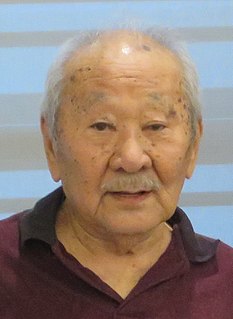Tanka is a genre of classical Japanese poetry and one of the major genres of Japanese literature.
Hawaiian literature has its origins in Polynesian mythology. It was originally preserved and expanded solely through oral traditions, as the ancient Hawaiians never developed a writing system. Written literature in the Hawaiian language and literary works in other languages by authors resident in Hawaii did not appear until the nineteenth century, when the arrival of American missionaries introduced the English language, the Latin alphabet, and Western notions of composition to the kingdom.

Kohala Historical Sites State Monument includes the National Historic Landmark Moʻokini Heiau and the birthplace of Kamehameha I. It is located in remote North Kohala on the Island of Hawaiʻi.
Lilikalā K. Kameʻeleihiwa is a Hawaiian historian, filmmaker, and senior professor at the University of Hawaiʻi's Kamakakūokalani Center for Hawaiian Studies. Her earliest work was published under the name of Lilikalā L. Dorton.
Lee A. Tonouchi is a Hawaii born writer and editor, who calls himself "Da Pidgin Guerilla" because of his strong advocacy of the Hawaiian Pidgin language.

Isami Doi was an American printmaker and painter.

Satoru Abe is a Japanese American sculptor and painter.

Fred H. Roster was an American sculptor known for his mixed media narrative sculptures. He was born in Palo Alto, California and grew up on a farm. Roster received an MA in ceramics from San José State University in 1968. He came to Hawaii in 1969 on his honeymoon and decided to stay. In 1970, he earned an MFA in sculpture from the University of Hawaii at Manoa. He joined the faculty of the University of Hawaii at Manoa in 1971, and retired as professor and chair of the sculpture program in 2016.
Wing Tek Lum is an American poet. Together with a brother he also manages a family-owned real estate company, Lum Yip Kee, Ltd.
Yasutaro (Keiho) Soga was a Hawaiian Issei journalist, poet and activist. He was a community leader among Hawaii's Japanese residents, serving as chief editor of the Nippu Jiji, then the largest Japanese-language newspaper in Hawaii and the mainland United States, and organizing efforts to foster positive Japan-U.S. relations and address discriminatory legislation, labor rights and other issues facing Japanese Americans. An accomplished news writer and tanka poet before the war, during his time in camp Soga authored one of the earliest memoirs of the wartime detention of Japanese Americans, Tessaku Seikatsu or Life Behind Barbed Wire.
Nora Okja Keller is a Korean American author. Her 1997 breakthrough work of fiction, Comfort Woman, and her second book (2002), Fox Girl, focus on multigenerational trauma resulting from Korean women's experiences as sex slaves, euphemistically called comfort women, for Japanese and American troops during World War II.
Rodney Morales is an American fiction writer, editor, literary scholar, musician, and Professor in the Creative Writing Program of the Department of English at the University of Hawaii. In both his creative and critical writing, he is concerned with contemporary multi-ethnic Hawaii society, particularly social relations between its residents of Native Hawaiian, Japanese, Caucasian, and Puerto Rican descent; the 1970s "Hawaiian Renaissance" movement and the disappearance of its legendary cultural icon George Helm of Protect Kaho'olawe Ohana (PKO); and the postmodern juxtaposition of popular artistic forms with high literature. Shaped by genre fiction of the postwar period, his regional stories influenced that of Generation X/millennial authors such as Chris McKinney and Alexei Melnick, "urban Honolulu" novelists known for their gritty, realistic approaches to depicting crime, drugs, and lower-class life in the islands.

Joseph Stanton is a Professor of Art History and American Studies at the University of Hawai‘i at Mānoa and a widely published poet.
Eric Chock is a Hawaiian poet, scholar and editor. He served as a professor of English and humanities at the University of Hawaii-West Oahu, and coordinated the state's "Poets in the Schools" program for more than twenty years.
Eric Paul Shaffer is an American novelist and poet, who lives and works in Hawai'i. Currently an assistant professor of English at Honolulu Community College, he formerly taught at Maui Community College and the University of the Ryukyus on Okinawa. His work has appeared in more than 400 national and international reviews, journals, and magazines, including Bamboo Ridge, the Chaminade Literary Review, the Chicago Review, the Chiron Review, Slate, The Sun Magazine, and the North American Review, as well as in the anthologies 100 Poets Against the War, The EcoPoetry Anthology, Jack London Is Dead: Contemporary Euro-American Poetry of Hawai‘i , Crossing Lines, In the Trenches, Weatherings, and The Soul Unearthed. He is the author of five collections of poetry and one novel.
Darlaine Mahealani Dudoit was a Hawaiian poet, essayist and editor. Her work appeared in the literary journals Manoa, the Hawaii Review, and The Southwest Review, as well as the anthologies Sister Stew, Growing Up Local, and Against Extinction.
Irma Tam Soong was a historian specializing in Hawaiian-Chinese history, and was notable for writing about her experiences during World War II in China during Japanese occupation. She founded the Hawaii Chinese History Center.
Tokiji "Sojin" Takei (April 6, 1903 – July 23, 1991) was a Japanese poet and essayist who lived in Hawaii. He was a prolific writer who is best known for his poetry written while he was incarcerated in a series of internment camps.
Otokichi "Muin" Ozaki was a Japanese tanka poet who lived in Hawaii.
Motokazu "Taisanboku" Mori was a Japanese surgeon and tanka poet who practiced in Hawaii.





